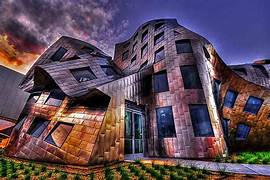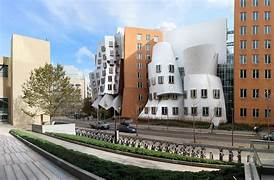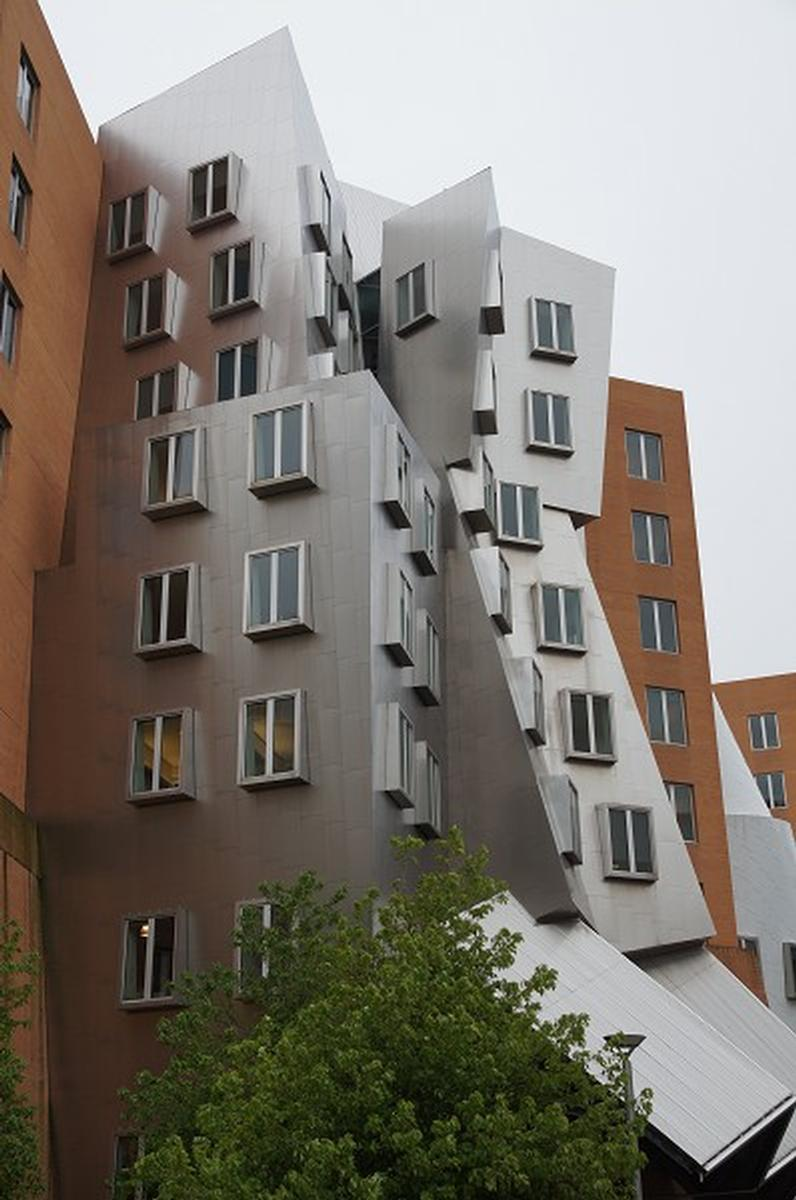Frank Gehry: The Master of Deconstructivist Architecture
Frank Gehry, born on February 28, 1929, in Toronto, Canada, is one of the most iconic and influential architects of the 20th and 21st centuries. Renowned for his innovative and often unconventional designs, Gehry has challenged architectural norms, embracing bold forms and materials that make his buildings instantly recognizable. His work is often categorized under the Deconstructivism movement, which emphasizes fragmented structures and non-linear processes of design.
Early Life and Education
Born Frank Owen Goldberg, Gehry moved to Los Angeles in 1947. He attended the University of Southern California, where he earned a degree in architecture in 1954. He later studied city planning at the Harvard Graduate School of Design, though he did not complete his degree there.
During his early career, Gehry experimented with various architectural styles, but it wasn’t until the 1970s that he truly began to explore the more abstract, sculptural forms that would come to define his career. A key turning point was the redesign of his own Santa Monica home, which featured raw materials like corrugated metal and plywood. This project became an architectural statement, signaling his departure from conventional design.
Signature Style and Approach
Frank Gehry’s work defies the constraints of traditional architecture, prioritizing form and expression over function. He is best known for his deconstructivist approach, characterized by the following:
.Non-Linear Forms: Gehry’s buildings often look like they’ve been distorted, twisted, or crumpled, giving them a sculptural appearance.
-
.Use of Unconventional Materials: He frequently employs materials like metal, glass, and even chain-link fences and corrugated steel.
.Organic Flow: Despite their chaotic appearance, Gehry’s designs often possess a sense of fluidity, as if the building is in motion.
His architectural style has influenced a generation of architects and transformed how we view the relationship between form and function.
Iconic Buildings
Gehry’s designs are celebrated worldwide for their creativity, and many of his buildings have become iconic landmarks.
1. Guggenheim Museum Bilbao (1997)One of Gehry’s most famous works, the **Guggenheim Museum** in Bilbao, Spain, is a masterpiece of modern architecture. The building’s twisting, curving titanium exterior has made it an architectural icon. The museum is often credited with revitalizing the city, a phenomenon known as the Bilbao Effect,where iconic buildings drive tourism and economic growth.
2. Walt Disney Concert Hall (2003) Located in Los Angeles, California, the Walt Disney Concert Hall is another of Gehry’s signature projects. With its stainless steel façade and sweeping, sail-like forms, the building is not only visually stunning but also acoustically exceptional, making it one of the premier concert venues in the world.
3. Dancing House (1996) Located in Prague, Czech Republic, this building, designed in collaboration with Croatian-Czech architect Vlado Milunić, is also known as "Fred and Ginger" due to its resemblance to a pair of dancers. Its whimsical and playful form stands in contrast to the classical architecture of Prague, making it a standout landmark.
4. Lou Ruvo Center for Brain Health (2010) Situated in Las Vegas, Nevada, this unique building features Gehry’s signature use of undulating forms and fragmented, deconstructed surfaces. The center's structure is designed to challenge the traditional concept of a healthcare building, offering a bold yet functional space for medical research and patient care.
5. Fondation Louis Vuitton (2014) Located in Paris, France, the Fondation Louis Vuitton is a museum and cultural center with a glass façade that looks like a giant ship. The building is composed of twelve massive glass “sails” that give the impression of movement, an illusion reinforced by the reflections on the glass.
6. MIT Stata Center (2004), Cambridge Gehry’s impact on educational architecture is evident in the MIT Stata Center. The building’s fragmented structure and use of vibrant colors challenge traditional institutional design, fostering a dynamic environment for learning and collaboration.
7. IAC Building (2007), New York In the heart of Manhattan, the IAC Building stands as a testament to Gehry’s ability to integrate technology and design seamlessly. The building’s innovative use of glass and a unique facade exemplify Gehry’s commitment to pushing the boundaries of architectural possibility.
8. Vitra Campus (1989), Weil am Rhein The Vitra Campus in Germany showcases Gehry’s early experimentation with form and materials. The Vitra Design Museum, with its sculptural design, adds a distinct artistic flair to the campus.
9. Neuer Zollhof (1999), Düsseldorf Gehry’s influence extends to Germany, where the Neuer Zollhof complex in Düsseldorf features three buildings with deconstructivist elements. The fluidity of form and the use of various materials create a visually striking ensemble.
10. MARTa Herford (2005), Germany The MARTa Herford museum in Germany exemplifies Gehry’s commitment to creating spaces that engage with their surroundings. The building’s dynamic form adds an artistic focal point to the city of Herford.
11. Weisman Art Museum (1993), Minneapolis Situated on the University of Minnesota campus, the Weisman Art Museum is another testament to Gehry’s ability to blend architecture with its natural surroundings. The stainless steel facade reflects the changing light, creating a dynamic visual experience.
12. Lou Ruvo Center for Brain Health (2010), Las Vegas Gehry’s architectural prowess extends to healthcare design, as seen in the Lou Ruvo Center for Brain Health. The building’s unique form reflects Gehry’s commitment to creating spaces that inspire hope and healing.
13. Ray and Maria Stata Center (2004), Cambridge Another notable work in Cambridge, the Ray and Maria Stata Center at MIT, showcases Gehry’s commitment to innovation in educational architecture. The building’s unconventional form fosters creativity and collaboration among students and faculty.
14. Gehry Residence (1978), Santa Monica Gehry’s own residence in Santa Monica serves as a testament to his early experimentation with unconventional materials. The exposed chain-link fence and the use of everyday materials reflect Gehry’s commitment to creating architecture that challenges norms.
15. Maggie’s Dundee (2003), Scotland Gehry’s humane approach to architecture is evident in Maggie’s Dundee, a cancer care center in Scotland. The building’s warm and inviting design contributes to the well-being of its users, showcasing Gehry’s ability to blend functionality with empathy.
Awards and Recognition
Frank Gehry has received numerous prestigious awards throughout his career, including:
-
.Pritzker Architecture Prize (1989): Often referred to as the "Nobel Prize of architecture," this honor solidified Gehry’s reputation as one of the world’s leading architects.
.American Institute of Architects Gold Medal (1999): The highest honor given by the AIA for a lifetime of distinguished achievement.
-
.Presidential Medal of Freedom (2016): Gehry was awarded the United States’ highest civilian honor by President Barack Obama for his contributions to architecture and culture.
Legacy and Influence
Frank Gehry’s work has transformed architecture into an art form. By breaking away from the strict confines of functionalist and minimalist architecture, he has opened up new possibilities for creative expression in the built environment. His iconic buildings often transcend their intended purpose, becoming cultural and artistic symbols in their own right.
Gehry’s innovative use of technology, including 3D modeling software like CATIA, has revolutionized the way architects design complex forms. His influence extends beyond architecture into fields like art, sculpture, and even furniture design, with his Easy Edges cardboard furniture line being a notable example.
Conclusion
Frank Gehry’s fearless creativity and willingness to push boundaries have made him a legend in the world of architecture. His buildings stand as testaments to the power of imagination and have reshaped the way we think about architecture’s role in society. Whether through the Guggenheim Museum in Bilbao or the Walt Disney Concert Hall in Los Angeles, Gehry has left an indelible mark on the world, and his work continues to inspire architects and designers around the globe.
---
This blog gives an overview of Frank Gehry’s life, work, and legacy, perfect for readers interested in architecture and design.
























![Terry Farrell [ British architect]](https://blogger.googleusercontent.com/img/b/R29vZ2xl/AVvXsEgF5Bc7-F6oyGHwVlcJfUVoN9PAph8ZIAQAVTMDZ0oOX0kIENEGN84Arj8wxKS666_yV2hRHMM4zlJ5gCJFBA1ttvrGBPrCNY0tZWfcuPl0aolt_szKpBjWtbLYutI4ivHBLrzZkj-wEk_l_1paoEEVkgnzCt7yvpHoDkhm63TxHxL45GUgV2OZVkwLYkWG/w100/11e81b6d-862f-4a23-a2d0-950d22063de0.png)



0 Comments